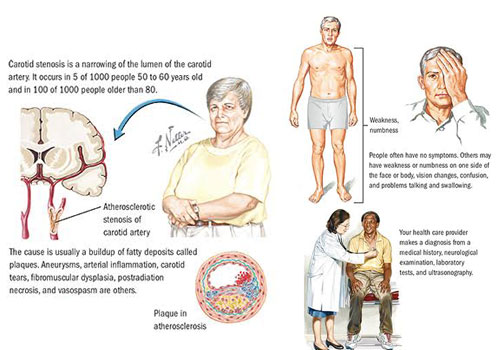Carotid Artery Disease (CAD)

What is Carotid Artery Disease?
Carotid Artery Disease (CAD) is a condition where the carotid arteries become narrowed or blocked (‘occluded’) by a buildup of plaque that is made up of fatty deposits called atherosclerosis.
You have two main carotid arteries that run up the neck and then split into internal and external carotid arteries. The internal carotid arteries supply oxygen-rich blood to your brain. The external carotid arteries supply oxygen-rich blood to your face, scalp, and neck.
Carotid Artery Disease is the result of the main carotid arteries becoming partially or fully blocked with this waxy plaque, preventing adequate blood flow to the brain.
This plaque can cause
- Stroke – a severe medical emergency
- Trans-ischaemic attack (TIA) colloquially known as a ‘mini stroke’, and
- Amaurosis fugax (a painless temporary loss of vision in one or both eyes)
Causes
Lifestyle conditions are mostly to blame for the damage caused to the arteries.
Major factors that contribute to this damage include:
- Smoking
- A history of smoking
- High levels of certain fats and cholesterol in the blood (hypercholesterolaemia)
- High blood pressure
- High levels of sugar in the blood due to insulin resistance or diabetes
Signs/symptoms
Carotid artery disease can go undetected (or be asymptomatic) until a problem develops like:
- Stroke
- Mini-stroke(TIA-transient ischemic attack)
- Visual disturbances (amaurosis fugax)
- Visual aura
- Temporary blindness (usually in one eye)
- One sided weaknesses
- Collapse/fainting
- Dizziness
- Tinnitus/ringing in the ears
How will Carotid Artery Disease affect my health?
Untreated CAD can be responsible for catastrophic life-altering and life-threatening stroke. Symptoms of stroke are severe, and can include half or full body paralysis.

What are the stages of Carotid Artery Disease?
Carotid Artery Disease can be long in the making, and asymptomatic for a very long time.
The stages can ‘fast-forward’ to a stroke or other life-altering event seemingly instantly if lifestyle improvements are not followed
Once detected, CAD should be monitored on a regular basis by ultrasound and under the guidance of a Vascular Surgeon.
If it progresses to a point where the risk of stroke is greater than the risks associated with surgery, appropriate surgery/stenting can be performed in a timely fashion.
What if I don’t have my Carotid Artery Disease treated?
Some people do not require intervention because it never progresses to a point where intervention is warranted.
However, everyone with Carotid Artery Disease should be under surveillance to monitor whether the disease is progressing or not, so that treatment can be provided as soon as possible.

How is diagnosis of carotid stenosis done?
Doppler scan is the first stage screening test.
CT angiogram helps to confirm the percentage of stenosis accurately and also to assess the blood circulation inside the brain
What treatment options does SVS offer for Carotid Artery Disease?
1)Conservative management
Monitor your symptoms and maintain regular visits
Improving your fitness and leading a healthy lifestyle
Control of cholesterol and sugar levels
Quitting smoking
Intervention for significant disease:
Two main methods for treating are:
- Carotid Endarterectomy
- Carotid Stent Surgery

Carotid Endarterectomy
This is an open procedure that involves an admission into hospital for 3-4 days.
The surgeon makes a vertical or curved incision in the neck to isolate the affected carotid artery. The aim of this procedure is to clear the buildup from inside the artery, so the surgeon will clamp the artery, make an incision and clean out the waxy residue. The clean artery will then be sutured, sometimes with the addition of a ‘patch’ made from another vein or from a synthetic material, and finally, the neck incision will be closed.

Carotid Stenting
Carotid Stenting is the insertion of a stent (a fine metal cylindrical scaffold) through a small incision in the groin. Special X-ray equipment and dye allow the surgeon to safely move the stent from your groin to your carotid artery in your neck.
The stent is designed to keep the artery open and to trap any plaque. Stenting is minimally invasive. The surgeon will consider very carefully whether you have disease morphology that is suitable for stenting.
Stenting procedure involves a filter device which helps to significantly reduced stroke during the procedure. Stenting is performed under angiographic control, with a local anaesthetic and sedation and usually takes approximately 2 hours. The hospital stay and admission is similar to the Carotid Endarterectomy.

After treatment
Good management of lifestyle factors
Important to have ongoing surveillance with your doctor
This will usually involve ultrasound of the carotid arteries, along with consultation. By doing this on a regular basis, you and your doctor can identify if your disease is recurring or progressing and offer adjustments to your treatment.
